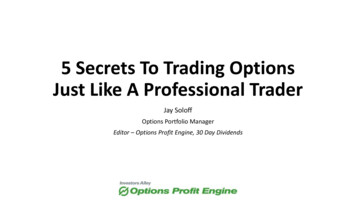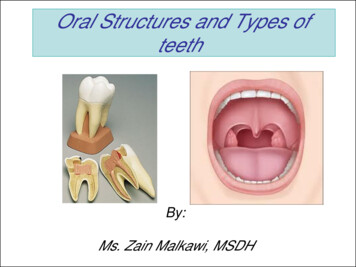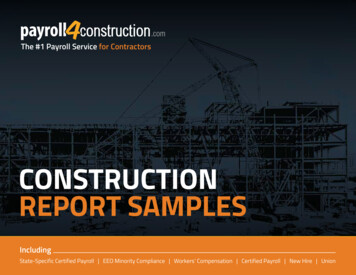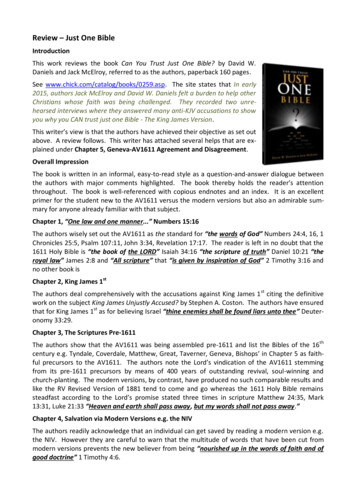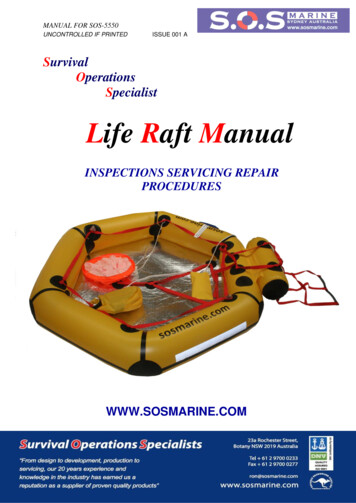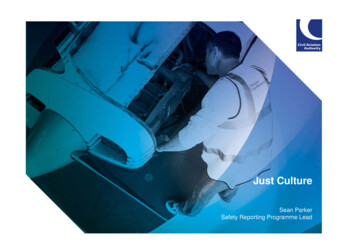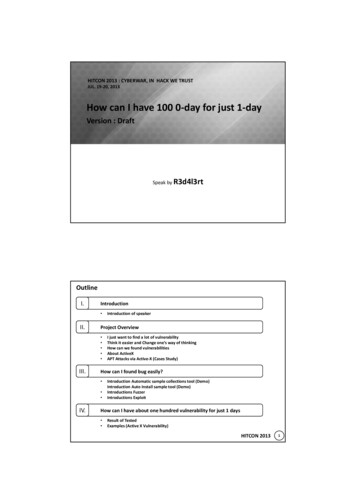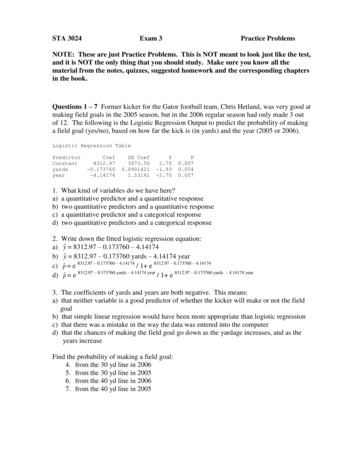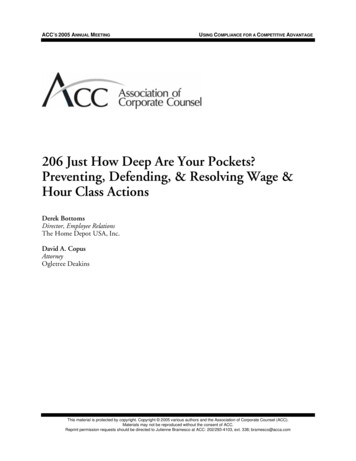
Transcription
ACC’S 2005 ANNUAL M EETINGU SING COMPLIANCE FOR A COMPETITIVE ADVANTAGE206 Just How Deep Are Your Pockets?Preventing, Defending, & Resolving Wage &Hour Class ActionsDerek BottomsDirector, Employee RelationsThe Home Depot USA, Inc.David A. CopusAttorneyOgletree DeakinsThis material is protected by copyright. Copyright 2005 various authors and the Association of Corporate Counsel (ACC).Materials may not be reproduced without the consent of ACC.Reprint permission requests should be directed to Julienne Bramesco at ACC: 202/293-4103, ext. 338; bramesco@acca.com
ACC's 2005 ANNUAL MEETINGUSING COMPLIANCE FOR A COMPETITIVE ADVANTAGETable of ContentsJust How Deep Are Your Pockets?I.The Seven Big Hits Under FLSA in the Last Year – Billion DollarsII.Comparatively SpeakingIII.Three Red Hot IssuesPreventing, Defending, and Resolving Wage & Hour Class ActionsIV.A.Legal – re salaried exempt workersB.Factual – re hourly workersC.Legal – re hourly workersFour Dangerous Damage Elements of FLSAOctober 17, 2005A.Virtually Automatic Double Damages for ViolationsAssociation of Corporate Counsel Annual MeetingWashington, DCB.Three year Statute of Limitations for Willful ViolationsC.Inability to Settle FLSA Claims Without DOL or Court ApprovalD.Difficulty in Taking Prospective Corrective Action OnlyV.David CopusOgletree, Deakins, Nash, Smoak & Stewart, P.C.Litigating an FLSA Collective Action—Part I: Opting In and the Authority to IssueNoticeA.The Original 1938 FLSAB.The 1947 Amendments in the Portal to Portal Act—Opt-In Required:C.To Notice or Not to Notice. That Was The Question for Forty Two Years.D.The Limit of Supreme Court Wisdom—Notice is DiscretionaryThis material is protected by copyright. Copyright 2005 various authors and the Association of Corporate Counsel (ACC).2
ACC's 2005 ANNUAL MEETINGVI.USING COMPLIANCE FOR A COMPETITIVE ADVANTAGELitigating an FLSA Collective Action—Part II: What Procedure Should Courts Follow inDetermining Whether to Send Notice?A.Lack of Controlling Guidance on Notice ProcedureB.Lack of Definitive Circuit Court Guidance on Notice ProcedureC.Trial Courts to the Rescue: The Now Ubiquitous Two-Stage Collective ActionCertification ProcedureX.VII.Litigating an FLSA Collective Action—Part III: What Factors and Quantum of ProofRegarding “Similarly Situated” Should the Court Use in Stage One?A.Chaos and the Lack of Appellate Court Guidance on Factors for “SimilarlySituated”B.Chaos Regarding the Quantum of Proof Concerning “Similarly Situated” DuringStage OneC.Allegations of Some Factors Are Sufficient at Stage OneD.Some Factual Showing Regarding Some Factors Necessary at Stage OneE.A Minor Diversion—Requiring Plaintiffs to Satisfy the Substantive Standards ofRule 23VIII.Litigating an FLSA Collective Action—Part IV: Stage Two’s Stricter StandardsRegarding “Similarly Situated”IX.Litigating an FLSA Collective Action—Part V: The NoticeA.Court’s Discretionary Power to Establish Contours of NoticeB.Possible Impropriety of Plaintiff’s Unsupervised Solicitation of Opt-InsC.Neutral Notice RequiredD.Content of NoticeE.Length of Opt-in PeriodF.Defense Counsel’s Contact with Potential Opt-Ins:An Ounce of PreventionA.Conduct Exempt Classification AuditB.Flag New Jobs for Rigorous Classification ReviewC.Establish Safe Harbor PolicyD,Develop and Publicize a Comprehensive Ban on Working “Off-the-ClockE.Adopt a Mandatory Arbitration ProgramThis material is protected by copyright. Copyright 2005 various authors and the Association of Corporate Counsel (ACC).3
ACC's 2005 ANNUAL MEETINGUSING COMPLIANCE FOR A COMPETITIVE ADVANTAGEJust How Deep Are Your Pockets?Preventing, Defending, and Resolving Wage & Hour Class ActionsC.David CopusOct. 17, 2005I.II.III.Alvarez v. IBP, Inc., 339 F.3d 894 (9th Cir. 2003), cert. granted, 125 S.Ct. 1292(Feb. 22, 2005)Tum v. Barber Foods, Inc., 360 F.3d 274 (1st Cir. 2004), cert. granted, 125 S.Ct.(Feb. 22, 2005)The Seven Big Hits Under FLSA in the Last Year – Billion Dollars 210 million, Farmers Insurance Exchange, misclassification of insurance claimsadjusters, Sept. 2004 135 million –State Farm Mutual Auto Ins. Co., misclassification of insuranceadjusters, Jan. 2005 48.5 million, Farmers Insurance Exchange, misclassification of insurance claimsadjusters, May 2005 37 million, Merrill Lynch, misclassification of brokers, Aug. 2005 30 million, Countrywide Home Loans, Inc., misclassification of accountexecutives, April 2005 24 million, Computer Sciences Corp., misclassification of technical supportemployees, March 2005 22.4 million, Albertsons, Inc., janitors’ claims of off-the-clock work andminimum wage violations, Jan. 2005Comparatively Speaking – in each of the last three years, plaintiffs’ lawyers have filedmore FLSA collective actions than Title VII class actions; plaintiffs’ lawyers aredefinitely ramping up their efforts under FLSA.Three Red Hot IssuesA.Legal – re salaried exempt workers – were workers properly classified as exemptfrom overtime requirementsB.Factual – re hourly workers – did hourly workers actually perform work “off theclock”? If so, they are entitled to overtime pay for all hours worked in excess of40 hours per week, even if the “off the clock” work violated express companypolicyLegal – re hourly workers – did admitted and unpaid activities of hourly workersconstitute compensable time?The Supreme Court has consolidated these two cases involving time spent byemployees after the employees don special protective clothing required by theemployer. Both courts of appeals held that the employers had to pay for thetime spent putting on and taking off the special protective clothing. The circuitcourts differed, however, on the issue of whether the employer had to pay forwaiting time after putting on the equipment and time walking to theworkstation at the beginning of the work day and the time spent walking backto the locker room at the end of the work day. The Ninth Circuit held that alltime was compensable between donning and doffing. The First Circuit heldthat the employer need not pay for waiting and walking time. The SupremeCourt will resolve that issue.IV.Three Dangerous Damage Elements of FLSAA.Virtually Automatic Double Damages for ViolationsThe FLSA provides that an employer that fails to pay required overtime “shall beliable to the employee or employees affected in the amount of their . . . unpaidovertime compensation . . . and in an additional equal amount as liquidateddamages.” 29 U.S. C. § 216(b).The FLSA provides an exceedingly narrow exception to the automatic award ofliquidated damages. Thus, a court may, “in its sound discretion, award noliquidated damages or award [reduced liquidated damages where] the employershows to the satisfaction of the court that the act or omission giving rise to [theviolation] was in good faith and that he had reasonable grounds for believing thathis act or omission was not a violation of the [FLSA].” 29 U.S. C. § 260.Wright v. Carrigg, 275 F.2d 448, 449 (4th Cir. 1960) (to avoid the payment ofliquidated damages for failing to pay required overtime, the employer has the“plain and substantial burden of persuading the court by proof that his failure toobey the state was both in good faith and predicated upon such reasonableThis material is protected by copyright. Copyright 2005 various authors and the Association of Corporate Counsel (ACC).4
ACC's 2005 ANNUAL MEETINGUSING COMPLIANCE FOR A COMPETITIVE ADVANTAGECox v. Brookshire Grocery Co., 919 F.2d 354, 356 (5th Cir. 1990) (burden is onplaintiff to prove the employer’s willfulness)grounds that it would be unfair to impose upon him more than a compensatoryverdict.”)Walton v. United Consumers Club, Inc., 786 F.2d 303, 310 (7th Cir. 1986) (theFLSA has a “strong presumption in favor of doubling” actual damages)C.Walton v. United Consumers Club, Inc., 786 F.2d 303, 306 (7th Cir. 1986) (courts“have refused to enforce wholly private settlements” of FLSA claims)Reich v. Southern New England Telecomm. Corp., 121 F.3d 58, n.71 (2d Cir.1997) (The employer’s burden to avoid payment of liquidated damages for aviolation of the FLSA’s overtime requirements “is a difficult one to meet . . . and‘[d]ouble damages are the norm, single damages the exception.’”)Williams v. Tri-County Growers, Inc., 747 F.2d 121, 129 (3rd Cir. 1984) (to satisfythe good faith exception and avoid the imposition of liquidated damages, theemployer has an affirmative duty to “ascertain the dictates” of the FLSA and thentaken appropriate steps to comply)Martin v. Cooper Elec. Supply Co., 940 F.2d 896, 910 (3rd Cir. 1991) (liquidateddamages mandatory where employer made no affirmative effort to ascertain theFLSA’s requirements but relied instead on industry practice)D.Brooklyn Savings Bank v. O’Neil, 324 U.S. 697, 707 (1945) (“the liquidateddamages provision is not penal in its nature, but constitutes compensation for theretention of a workman’s pay which might be too obscure and difficult of prooffor estimate other than by liquidated damages”)B.Three year Statute of Limitations for Willful ViolationsThe FLSA’s usual two-year limitations period is extended to three years wherethe employer’s conduct was willful. 29 U.S.C. § 255(a).McLaughlin v. Richland Shoe Co., 486 U.S. 128 (1988) (the employer actswillfully within the meaning of the FLSA where the employer knew the conductwas unlawful or acted with reckless disregard for whether the actions violated theFLSA)Difficulty in Taking Prospective Corrective Action OnlyUnlike changing many employment practices, a significant change in howemployees are paid is likely to signal backpay dollar signs in the eyes of at leastsome employees.V.Litigating an FLSA Collective Action—Part I: Opting In and the Authority to IssueNoticeA.The Original 1938 FLSAIn 1938, Congress passed the FLSA and authorized an employee to sue on his orher on behalf and on behalf of all “similarly situated” individuals. The originalstatute also authorized employees to designate a third party to bring an action ontheir behalf and all other “similarly situated” employees. The act did not requireany written consent to be filed by the “similarly situated” employees. Everyoneand his or her next friend soon filed massive FLSA lawsuitsBrock v. Wilamowsky, 833 F.2d 11, 19-20 (2nd Cir. 1987) (conformity to“customary and widespread” industry practices that violate the FLSA does notdemonstrate the good faith needed to avoid liquidated damages)Braswell v. City of El Dorado, Ark., 187 F.3d 954, 956 (8th Cir. 1999) (employermust pay liquidated damages even where the employer voluntarily paid full backpay before trial)Inability to Settle FLSA Claims Without DOL or Court ApprovalB.The 1947 Amendments in the Portal to Portal Act—Opt-In Required:In response to the unanticipated avalanche of private lawsuits, in 1947, throughthe Portal to Portal Act, Congress reiterated the provision of the original FLSAthat an individual may sue on his own behalf and on behalf of “other employeessimilarly situated” but added a significant new restriction: “no employee shall bea party plaintiff unless he gives his consent in writing and such consent is filedwith the court.” This new restriction created the unique opt-in structure of FLSAcollective actions. Congress offered no other guidance on the process of privateenforcement actions under the opt-in process. 29 U.S.C. § 216(b)Hoffman-LaRoche, Inc. v. Sperling, 493 U.S. 165, 173-74 (1989) (“[i]n partresponding to excessive litigation spawned by plaintiffs lacking a personal interestin the outcome, the representative action by plaintiffs not themselves possessingclaims was abolished [by Congress in 1947], and the requirement that anemployee file a written consent was added. . . . The relevant amendment was forthe purpose of limiting private FLSA plaintiffs to employees who asserted claimsThis material is protected by copyright. Copyright 2005 various authors and the Association of Corporate Counsel (ACC).5
ACC's 2005 ANNUAL MEETINGUSING COMPLIANCE FOR A COMPETITIVE ADVANTAGEin their own right and freeing employers of the burden of representative actions. . . Congress left intact the ‘similarly situated’ language providing for collectiveactions.”)D.In Hoffman-LaRoche, the Supreme Court established a single, narrow proposition:a trial court could, “in appropriate cases,” authorize the plaintiffs to send a noticeto putatively “similarly situated” individuals in a law suit brought pursuant to §216(b) of the FLSA. The Supreme Court did not mandate notice. Nor did theSupreme Court opine on the procedures the trial court should use in authorizingthe notice or on the standards by which the trial court should exercise itsdiscretion in determining whether to authorize notice at all.Cameron-Grant v. Maxim Healthcare Servs., Inc., 347 F.3d 1240, 1248-49 (11thCir. 2003) (Congress mandated an opt-in procedure for FLSA suits “to prohibitwhat precisely is advanced under Rule 23—a representative plaintiff filing anaction that potentially may generate liability in favor of uninvolved classmembers;” if an employee does not opt-in to an FLSA collective action, theemployee cannot “be bound by or . . . benefit from the judgment in the case.”A major share of FLSA litigation since 1989 has focused on those two issues, inlarge part because the procedures and standards for notice play a critical role inthe tactical decisions that FLSA litigators must make. Moreover, the two issuesare inextricably linked. A court cannot authorize notice without having aprocedure for that notice; nor can it authorize notice without determining whoshould receive the notice. Trial courts have found themselves in a chicken-eggsituation as they have sought to implement the FLSA’s opt-in process.Arrington v. Nat’l Broadcasting Co., 531 F. Supp. 498, 501 (D.D.C. 1982)(Congress added the opt-in requirement to the FLSA to “prevent large groupactions, with their vast allegations of liability, from being brought on behalf ofemployees who had no real involvement in, or knowledge of, the lawsuit”)C.To Notice or Not to Notice. That Was The Question for Forty Two Years.Hoffman-LaRoche, Inc. v. Sperling, 493 U.S. 165, 170 (1989) (while trial courtshave discretion to issue notice in FLSA cases, such notices should be sent only“in appropriate cases”)Almost immediately after Congress added the opt-in requirement in 1947,plaintiffs began to wonder: how will employees be able to opt-in if they don’teven know that a lawsuit has been filed? Although nothing in the statute itself, theact’s legislative history, or the Department of Labor’s regulations provided anyguidance, the solution seemed plain to plaintiffs: the district court shouldauthorize plaintiffs to send out a notice to all individuals who were allegedlysimilarly situated to the named plaintiffs. Defendants hotly contested thisproposition and fought hammer and tongs for forty two years over the issue ofnotice.The notice issue did not plague suits initiated by the Secretary of Labor, however,because the statute plainly authorized the Secretary to sue on behalf of anyaggrieved individual. But the procedural question of the authority of trial courts toapprove the sending of a notice dominated private FLSA enforcement lawsuits.As the battle raged, the circuits split evenly. The Supreme Court finally resolvedthe matter in 1989.Hoffman-LaRoche, Inc. v. Sperling, 493 U.S. 165, 169-170 (1989) (benefits of ancollective action brought pursuant to § 216 (b) of the FLSA—including “efficientresolution in one proceeding of common issues of law and fact arising from thesame alleged” practice—depend on employees receiving accurate and timelynotice about the collective action; therefore, “district courts have discretion . . . toimplement” § 216(b) of the FLSA “by facilitating notice to potential plaintiffs”)The Limit of Supreme Court Wisdom—Notice is DiscretionaryHall v. Burk, No. 01-2478, 2002 WL 413901 (N.D. Tex. March 12, 2002) (noticein FLSA cases is discretionary and “by no means mandatory”)White v. Osmose, Inc., 204 F. Supp. 2d 1309, 1312 (M.D. Ala. 2002) (notice inFLSA cases is discretionary with the court and should be sent “only in appropriatecases”)Camper v. Home Quality Mgmt., Inc., 200 F.R.D. 516, 519 (D. Md. 2000) (“therelevant inquiry then is not whether the Court has discretion to facilitate notice,but whether this is an appropriate case in which to exercise discretion”)VI.Litigating an FLSA Collective Action—Part II: What Procedure Should CourtsFollow in Determining Whether to Send Notice?A.Lack of Controlling Guidance on Notice ProcedureInasmuch as the FLSA offers no direction on whether trial courts had theauthority to issue any notice in the first place, a fortiori the statue provide noguidance on the proper procedure for judicial approval of such a notice. Inaddition, the Department of Labor has provided no regulatory guidance, and theSupreme Court’s decision in Hoffman-LaRoche left the procedural slate blank.This material is protected by copyright. Copyright 2005 various authors and the Association of Corporate Counsel (ACC).6
ACC's 2005 ANNUAL MEETINGUSING COMPLIANCE FOR A COMPETITIVE ADVANTAGEThiessen v. Gen. Elec. Cap. Corp., 267 F.3d 1095, 1102-03 (10th Cir. 2001)(district court did not abuse its discretion in applying the two-stage process ofcertification; court did not mandate the two-stage process, however)Brian R. Gates, A “Less Stringent” Standard? How to Give FLSA Section 16(b) aLife of Its Own, 80 Notre Dame L. Rev. 1519, 1521 (April 2005) (“thecongressional record is virtually silent as to how Congress intended for section16(b) to operate in practice”)Hipp v. Liberty Nat’l Life Ins. Co., 252 F.3d 1208, 1219 (11th Cir. 2001)(affirming trial court’s certification of a collective action even though the lowercourt did not utilize the familiar two-stage approach; while observing that thetwo-stage approach “appears to be an effective tool” for determining the existencevel non of a group of “similarly situated” employees, the court merely suggested“that district courts in this circuit adopt it in the future” but simultaneously notingthat “[n]othing in our circuit precedent . . . requires district courts to use thisapproach”)Hoffman-LaRoche, Inc. v. Sperling, 493 U.S. 165, 170 (1989) (although theSupreme Court held that a trial court had discretion to issue notice in an actionbrought under § 216 (), the court made it plain that its decision merely“confirm[ed] the existence of the trial court’s discretion, not the details of itsexercise”)B.Lack of Definitive Circuit Court Guidance on Notice ProcedureEven as we speak in 2005, not only has the Supreme Court not provided cleardirection on the proper procedure for determining whether to authorize plaintiffsto issue notice to putatively “similarly situated” individuals, the circuit courtshave likewise failed to provide definitive guidance to the trial courts within theirrespective appellate jurisdictions. The courts of appeals have repeatedly said onlythat a particular procedural approach was within the trial court’s discretion. Noappellate decision has mandated a particular procedure. Nor has any court ofappeals rejected a trial’s courts chosen procedure.Despite the lack of a definitive rulings from even one appellate court mandating aparticular procedure for approving notice, four firm conclusions emerge fromappellate decisions on the FLSA’s notice procedure: (1) trial courts have widediscretion in fashioning a notice procedure; (2) trial courts do not abuse theirdiscretion by following the now standard two-stage notice process (described inthe succeeding section); (3) trial courts need not follow the standard two-stagenotice process; and (4) the procedures of Rule 23, Fed. R. Civ. Proc., do not applyto the FLSA notice process.Mooney v. Aramco Servs. Co., 54 F. 3d 1207, 1213-14, 1216 (5th Cir. 1995)(affirming trial court’s decertification of collective action; court found it“unnecessary to decide” which appro
adjusters, Sept. 2004 135 million –State Farm Mutual Auto Ins. Co., misclassification of insurance adjusters, Jan. 2005 48.5 million, Farmers Insurance Exchange, misclassification of insurance claims adjusters, May 2005 37 millio

